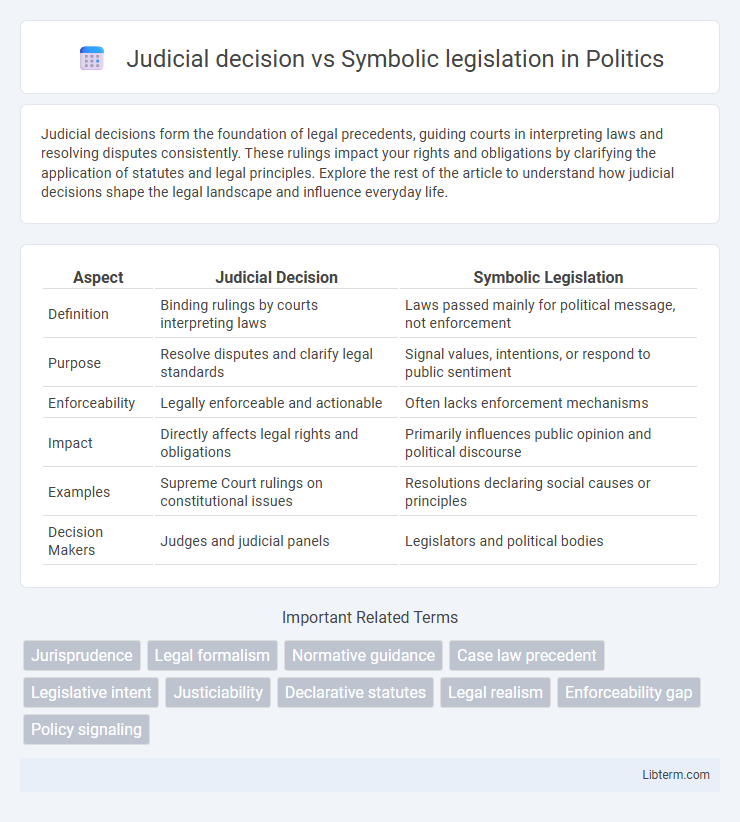Judicial decisions form the foundation of legal precedents, guiding courts in interpreting laws and resolving disputes consistently. These rulings impact your rights and obligations by clarifying the application of statutes and legal principles. Explore the rest of the article to understand how judicial decisions shape the legal landscape and influence everyday life.
Table of Comparison
| Aspect | Judicial Decision | Symbolic Legislation |
|---|---|---|
| Definition | Binding rulings by courts interpreting laws | Laws passed mainly for political message, not enforcement |
| Purpose | Resolve disputes and clarify legal standards | Signal values, intentions, or respond to public sentiment |
| Enforceability | Legally enforceable and actionable | Often lacks enforcement mechanisms |
| Impact | Directly affects legal rights and obligations | Primarily influences public opinion and political discourse |
| Examples | Supreme Court rulings on constitutional issues | Resolutions declaring social causes or principles |
| Decision Makers | Judges and judicial panels | Legislators and political bodies |
Defining Judicial Decisions and Symbolic Legislation
Judicial decisions are authoritative rulings issued by courts that interpret and apply laws to resolve specific legal disputes, thereby establishing binding precedents for future cases. Symbolic legislation refers to laws enacted primarily for their expressive value rather than practical enforcement, aiming to signal political or social intentions without imposing significant legal obligations. Understanding the distinction involves recognizing judicial decisions as concrete applications of law with tangible legal effects, whereas symbolic legislation functions more as a tool for public communication and policy signaling.
Historical Context and Evolution
Judicial decision in historical context evolved as courts interpreted laws to adapt to changing societal values, often filling gaps left by legislative bodies. Symbolic legislation emerged as a political tool to express ideals or appease public opinion, frequently lacking enforceable provisions. Over time, judicial decisions gained authoritative power through precedent, while symbolic laws highlighted tensions between legal formality and social messaging.
Key Differences Between Judicial Decisions and Symbolic Legislation
Judicial decisions are authoritative interpretations of laws made by courts based on legal precedents and statutory provisions, ensuring binding outcomes in specific cases. Symbolic legislation, by contrast, expresses the legislature's intentions or societal values without imposing enforceable legal obligations or practical effects. The key difference lies in judicial decisions providing concrete rulings impacting rights and duties, whereas symbolic legislation primarily serves rhetorical or moral purposes without direct legal enforcement.
Purpose and Functions in Legal Systems
Judicial decisions serve the purpose of interpreting and applying laws to specific cases, providing binding precedents that ensure consistency and predictability in legal systems. Symbolic legislation primarily functions to express societal values or political stances without necessarily creating enforceable regulations, often aiming to influence public opinion or signal commitment to particular issues. In legal systems, judicial decisions directly impact legal outcomes and rights enforcement, while symbolic legislation shapes social norms and political discourse.
Impact on Public Policy and Society
Judicial decisions shape public policy by interpreting laws in specific cases, often setting legal precedents that influence future rulings and societal norms. Symbolic legislation, while primarily expressing values or political stances, can raise awareness and signal government priorities without always producing immediate legal or social changes. The impact of judicial decisions tends to be more direct and enforceable, whereas symbolic laws often drive gradual shifts in public opinion and cultural attitudes.
Influence on Legal Interpretation and Precedent
Judicial decisions significantly influence legal interpretation by establishing precedents that guide future case rulings, ensuring consistency and adaptability within the judiciary. Symbolic legislation, while often enacted to express political or social values, typically lacks direct binding impact on judicial precedent and serves more as a statement than a source of legal obligation. The dynamic interplay between binding judicial precedents and non-binding symbolic laws shapes the evolution of legal norms without undermining the authoritative role of courts in interpreting statutes.
Case Studies: Judicial Decisions vs Symbolic Laws
Judicial decisions, such as Brown v. Board of Education, demonstrate tangible legal change by directly overturning segregation policies, contrasting with symbolic legislation like the Equal Rights Amendment, which raised awareness but lacked enforceable power. Unlike symbolic laws that often serve as political statements or moral commitments without immediate impact, judicial rulings establish binding precedents that reshape the legal landscape and influence future case interpretations. Case studies highlight how courts' authoritative decisions provide concrete legal remedies, whereas symbolic legislation primarily functions to express societal values without altering statutory obligations.
Criticisms and Controversies
Judicial decisions often face criticism for perceived judicial activism, where courts are accused of creating law rather than interpreting it, potentially undermining democratic processes. Symbolic legislation is criticized for being largely performative, enacting laws without enforceable provisions or practical impact, which may mislead the public and waste resources. Both approaches spark controversies over accountability, with judicial rulings seen as bypassing electoral mandates and symbolic laws viewed as superficial gestures lacking substantive change.
The Role of Media and Public Perception
Media plays a critical role in shaping public perception of judicial decisions by framing legal outcomes and influencing societal acceptance or dissent. Symbolic legislation often relies on media coverage to amplify political messages, creating a perception of action even when legal impact is limited. The interplay between media portrayal and public opinion can pressure courts or lawmakers, affecting the legitimacy and enforcement of both judicial rulings and symbolic laws.
Future Trends and Challenges
Judicial decisions increasingly shape legal landscapes by interpreting complex statutes and adapting laws to evolving societal norms, while symbolic legislation often serves more to express political values than implement concrete policies. Future trends indicate a growing reliance on judicial review to resolve disputes arising from symbolic laws with ambiguous enforcement, posing challenges in maintaining legislative clarity and democratic accountability. Balancing judicial activism with legislative intent remains critical as courts navigate the complexities of rights expansion and policy symbolism in diverse jurisdictions.
Judicial decision Infographic

 libterm.com
libterm.com